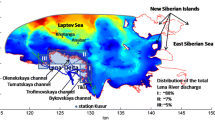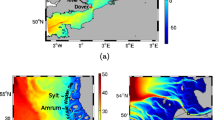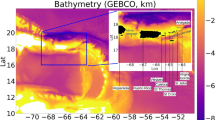Abstract
In the context of the emergence of extra-terrestrial oceanography, we adapted an existing oceanographic model, SLIM (www.climate.be/slim), to the conditions of Titan, a moon of Saturn. The tidal response of the largest southern lake at Titan’s surface, namely Ontario Lacus, is simulated. SLIM solves the 2D, depth-averaged shallow water equations on an unstructured mesh using the discontinuous Galerkin finite element method, which allows for high spatial resolution wherever needed. The impact of the wind forcing, the bathymetry, and the bottom friction is also discussed. The predicted maximum tidal range is about 0.56 m in the southern part of the lake, which is more than twice as large as the previous estimates (see Tokano, Ocean Dyn 60:(4) 803–817 10.1007/s10236-010-0285-3 (Tokano 2010)). The patterns and magnitude of the current are also markedly different from those of previous studies: the tidal motion is not aligned with the major axis of the lake and the speed is larger nearshore. Indeed, the main tidal component rotates clockwise in an exact period of one Titan day and the tidal currents can reach 0.046 ms −1 close to the shores depending on the geometry and the bathymetry. Except for these specific nearshore regions, the current speed is less than 0.02 ms −1. Circular patterns can be observed offshore, their rotational direction and size varying along the day.















Similar content being viewed by others
Notes
Imaging Science Subsystem: it takes pictures in visible, near-ultraviolet, and near-infrared light. (see Porco et al, 2004).
Radar: it maps the surface of Titan using a radar imager to pierce the veil of haze. It is also used to measure heights of surface features. The synthetic aperture radar observed Titan in 13.78 GHz Ku-band with a resolution ranging from 0.35 to 1.7 km (see Elachi et al, 2004).
The largest lakes are referred to as seas (Mare) and the others as lakes (Lacus), according to the nomenclature of the International Astronomical Union. It only reflects the size of the lake.
The true anomaly of Titan, L s , is the angle between the direction of the perikron and the current position of Titan as seen from Saturn.
Visible and Infrared Mapping Spectrometer: it identifies the chemical compositions of the surfaces, atmospheres, and rings of Saturn and its moons by measuring colors of visible light and infrared energy emitted or reflected (Brown et al. 2004).
Composite Infrared Spectromter : it measures infrared energy from the surfaces, atmospheres, and rings of Saturn and its moons to study their temperature and compositions (Flasar et al. 2004).
The loss tangent is the tangent of the loss angle. It is used to parametrise the electromagnetic energy dissipation inherent to a dielectric material.
This composition is shown in Table 3 of Cordier et al. (2009). The main constituents and their lake mole fraction are C 2 H 6 (7.64 × 10−1), CH 4 (9.69 × 10−2), C 3 H 8 (7.42 × 10−2), C 4 H 8 (1.39 × 10−2), N 2 (4.9 × 10−3), Ar (5.01 × 10−6), CO (4.21 × 10−7), and H 2 (3.99 × 10−11).
In this paper, the words “maximum depth” refer to the maximum depth of the implemented bathymetry and not the maximum depth on the lake which is a function of the resolution of the data.
For interpretation of the references to color, the reader is referred to the web version of this article.
Such a wind speed is strong in comparison with Titan standards: the wind is lower than 0.7 ms −1 most of the time.
References
Aharonson O, Hayes AG, Lunine JI, Lorenz RD, Allison MD, Elachi C (2009) An asymmetric distribution of lakes on Titan as a possible consequence of orbital forcing. Nat Geosci 2(12):851–854. doi:10.1038/ngeo698
Barnes JW, Brown RH, Soderblom JM, Soderblom LA, Jaumann R, Jackson B, Le Mouélic S, Sotin C, Buratti BJ, Pitman KM et al (2009) Shoreline features of Titan’s Ontario Lacus from Cassini/VIMS observations. Icarus 201(1):217–225. doi:10.1016/j.icarus.2008.12.028
Bernard PE, Chevaugeon N, Legat V, Deleersnijder E, Remacle JF (2007) High-order h-adaptive discontinuous galerkin methods for ocean modelling. Ocean Dyn 57(2):109–121. doi:10.1007/s10236-006-0093-y
Beuthe M (2015) Tidal Love numbers of membrane worlds: europa, Titan, and Co. Icarus 258(57):239–266. doi:10.1016/j.icarus.2015.06.008
Brown RH, Baines KH, Bellucci G, Bibring JP, Buratti BJ, Capaccioni F, Cerroni P, Clark RN, Coradini A, Cruikshank DP et al (2004) The Cassini visual and infrared mapping spectrometer (VIMS) investigation. In: The Cassini-Huygens Mission. Springer, pp 111–168. doi:10.1007/1-4020-3874-7_3
Brown RH, Soderblom LA, Soderblom JM, Clark RN, Jaumann R, Barnes JW, Sotin C, Buratti B, Baines KH, Nicholson PD (2008) The identification of liquid ethane in Titan’s Ontario Lacus. Nature 454 (7204):607–610. doi:10.1038/nature07100
De Brye B, De Brauwere A, Gourgue O, Kärnä T, Lambrechts J, Comblen R, Deleersnijder E (2010) A finite-element, multi-scale model of the Scheldt tributaries, river, estuary and ROFI. Coast Eng 57(9):850–863. doi:10.1016/j.coastaleng.2010.04.001
De Brye B, Schellen S, Sassi M, Vermeulen B, Kärnä T, Deleersnijder E, Hoitink T (2011) Preliminary results of a finite-element, multi-scale model of the Mahakam Delta (Indonesia). Ocean Dyn 61(8):1107–1120. doi:10.1007/s10236-011-0410-y
Cordier D, Mousis O, Lunine JI, Lavvas P, Vuitton V (2009) An estimate of the chemical composition of Titan’s lakes. Astrophys J Lett 707(2):L128. doi:10.1088/0004-637X/707/2/L128
Cordier D, Mousis O, Lunine JI, Lebonnois S, Rannou P, Lavvas P, Lobo LQ, Ferreira AGM (2012) Titan’s lakes chemical composition: sources of uncertainties and variability. Planet Space Sci 61(1):99–107. doi:10.1016/j.pss.2011.05.009
Cottini V, Nixon CA, Jennings DE, de Kok R, Teanby NA, Irwin PGJ, Flasar FM (2012) Spatial and temporal variations in Titan’s surface temperatures from Cassini CIRS observations. Planet Space Sci 60(1):62–71. doi:10.1016/j.pss.2011.03.015
Dermott SF, Sagan C (1995) Tidal effects of disconnected hydrocarbon seas on Titan. Nature 374 (6519):238–240. doi:10.1038/374238a0 10.1038/374238a0
Drews C (2013) Using wind setdown and storm surge on Lake Erie to calibrate the air-sea drag coefficient. PloS ONE 8(8):e72,510. doi:10.1371/journal.pone.0072510
Elachi C, Allison MD, Borgarelli L, Encrenaz P, Im E, Janssen MA, Johnson WTK, Kirk RL, Lorenz RD, Lunine JI et al (2004) Radar: the Cassini titan radar mapper. Space Sci Rev 115(1-4):71–110. doi:10.1007/s11214-004-1438-9
Flasar FM, Kunde VG, Abbas MM, Achterberg RK, Ade P, Barucci A, Bézard B, Bjoraker GL, Brasunas JC, Calcutt S et al (2004) Exploring the saturn system in the thermal infrared: The composite infrared spectrometer. In: The Cassini-Huygens Mission. doi:10.1007/1-4020-3874-7_4. Springer, pp 169–297
Friedson AJ, West RA, Wilson EH, Oyafuso F, Orton GS (2009) A global climate model of Titan’s atmosphere and surface. Planet Space Sci 57(14):1931–1949. doi:10.1016/j.pss.2009.05.006
Fulchignoni M, Ferri F, Angrilli F, Ball AJ, Bar-Nun A, Barucci MA, Bettanini C, Bianchini G, Borucki W, Colombatti G et al (2005) In situ measurements of the physical characteristics of Titan’s environment. Nature 438(7069):785–791. doi:10.1038/nature04314
Geuzaine C, Remacle JF (2009) Gmsh: a 3-d finite element mesh generator with built-in pre-and post-processing facilities. Int J Numer Methods Eng 79(11):1309–1331. doi:10.1002/nme.2579
Glein CR, Shock EL (2013) A geochemical model of non-ideal solutions in the methane-ethane-propane-nitrogen-acetylene system on Titan. Geochim Cosmochim Ac 115:217–240. doi:10.1016/j.gca.2013.03.030
Hamblin PF (1982) On the free surface oscillations of Lake Ontario. Limnol Oceanogr 27(6):1039–1049. doi:10.4319/lo.1982.27.6.1039
Hanel R, Conrath B, Flasar FM, Kunde V, Maguire W, Pearl J, Pirraglia J, Samuelson R, Herath L, Allison M, Cruikshank D, Gautier D, Gierasch P, Horn L, Koppany R, Ponnamperuma C (1981) Infrared observations of the saturnian system from Voyager-1. Science 212:192–200. doi:10.1126/science.212.4491.192
Hayes AG (2016) The lakes and seas of Titan. Ann Rev Earth Planet Sci:44. doi:10.1146/annurev-earth-060115-012247
Hayes AG, Aharonson O, Callahan P, Elachi C, Gim Y, Kirk RL, Lewis K, Lopes R, Lorenz RD, Lunine JI et al (2008) Hydrocarbon lakes on titan: distribution and interaction with a porous regolith. Geophys Res Lett 35(9). doi:10.1029/2008GL033409
Hayes AG, Wolf AS, Aharonson O, Zebker H, Lorenz RD, Kirk RL, Paillou P, Lunine JI, Wye L, Callahan P et al (2010) Bathymetry and absorptivity of Titan’s Ontario Lacus. J Geophys Res-Planet 115(E9):E09, 009. doi:10.1029/2009JE003557
Hayes AG, Aharonson O, Lunine JI, Kirk RL, Zebker HA, Wye LC, Lorenz RD, Turtle EP, Paillou P, Mitri G et al (2011) Transient surface liquid in Titan’s polar regions from Cassini. Icarus 211 (1):655–671. doi:10.1016/j.icarus.2010.08.017
Hayes AG, Michaelides RJ, Turtle EP, Barnes JW, Soderblom JM, Masrtogiuseppe M, Lorenz RD, Kirk RL, Lunine JI (2014) The distribution and volume of Titan’s hydrocarbon lakes and seas. In: Lunar and planetary institute science conference abstracts, vol 45, p 2341
Howarth MJ (2005) Hydrography of the Irish sea Sea6 technical report. Department of Trade and Industry offshore energy Strategic Assessment programme, UK
Iess L, Jacobson RA, Ducci M, Stevenson DJ, Lunine JI, Armstrong JW, Asmar SW, Racioppa P, Rappaport NJ, Tortora P (2012) The tides of Titan. Science 337(6093):457–459. doi:10.1126/science.1219631
Jennings DE, Flasar FM, Kunde VG, Samuelson RE, Pearl JC, Nixon CA, Carlson RC, Mamoutkine AA, Brasunas JC, Guandique E et al (2009) Titan’s surface brightness temperatures. Astrophys J Lett 691(2):L103. doi:10.1088/0004-637X/691/2/L103
Jennings DE, Cottini V, Nixon CA, Flasar FM, Kunde VG, Samuelson RE, Romani PN, Hesman BE, Carlson RC, Gorius NJP et al (2011) Seasonal changes in Titan’s surface temperatures. Astrophys J Lett 737(1):L15. doi:10.1088/2041-8205/737/1/L15
Kärnä T, De Brye B, Gourgue O, Lambrechts J, Comblen R, Legat V, Deleersnijder E (2011) A fully implicit wetting-drying method for DG-FEM shallow water models, with an application to the Scheldt Estuary. Comput Method Appl M 200(5):509–524. doi:10.1016/j.cma.2010.07.001
Lambrechts J, Comblen R, Legat V, Geuzaine C, Remacle JF (2008a) Multiscale mesh generation on the sphere. Ocean Dyn 58(5-6):461–473. doi:10.1007/s10236-008-0148-3
Lambrechts J, Hanert E, Deleersnijder E, Bernard PE, Legat V, Remacle JF, Wolanski E (2008b) A multi-scale model of the hydrodynamics of the whole Great Barrier Reef. Estuar Coast Shelf S 79(1):143–151. doi:10.1016/j.ecss.2008.03.016
Lebonnois S, Burgalat J, Rannou P, Charnay B (2012) Titan global climate model: a new 3-dimensional version of the IPSL Titan GCM. Icarus 218(1):707–722. doi:10.1016/j.icarus.2011.11.032
Legrand S, Deleersnijder E, Hanert E, Legat V, Wolanski E (2006) High-resolution, unstructured meshes for hydrodynamic models of the great barrier reef, Australia. Estuar, Coastal Shelf Sci 68(1):36–46. doi:10.1016/j.ecss.2005.08.017
Lopez Gonzalez T, Bourgeois O, Le Mouélic S, Rodriguez S, Lopez Gonzalez T, Sotin C, Tobie G, Fleurant C, Barnes JW, Brown RH et al (2012) Geomorphological significance of Ontario Lacus on Titan: integrated interpretation of Cassini VIMS ISS and RADAR data and comparison with the Etosha Pan (Namibia). Icarus 218(2):788–806. doi:10.1016/j.icarus.2012.01.013
Lorenz RD, Lunine JL, Neish CD (2011) Cyanide soap? Dissolved materials in Titan’s seas. EPSC-DPS2011 6:488
Lorenz RD (2013) Oceanography on Saturn’s moon, Titan. In: Oceans-san diego, 2013. IEEE, pp 1–7
Lorenz RD, Newman C, Lunine JI (2010) Threshold of wave generation on Titan’s lakes and seas: effect of viscosity and implications for Cassini observations. Icarus 207(2):932–937. doi:10.1016/j.icarus.2009.12.004
Lorenz RD, Tokano T, Newman CE (2012) Winds and tides of Ligeia Mare, with application to the drift of the proposed TiME (Titan Mare Explorer) capsule. Planet Space Sci 60(1):72–85. doi:10.1016/j.pss.2010.12.009
Lorenz RD, Kirk RL, Hayes AG, Cassini AG, Anderson YZ, Lunine JI, Tokano T, Turtle EP, Malaska MJ, Soderblom JM, Lucas A, et al (2014) A radar map of Titan seas: Tidal dissipation and ocean mixing through the throat of Kraken. Icarus 237:9–15. doi:10.1016/j.icarus.2014.04.005
Lunine JI, Hayes A, Aharonson O, Mitri G, Lorenz R, Stofan E, Wall S, Elachi C, Cassini Radar Team et al (2009) Evidence for liquid in Ontario Lacus (Titan) from Cassini-observed changes. In: AAS/Division for planetary sciences meeting abstracts# 41 , vol 41
Luspay-Kuti A, Chevrier VF, Cordier D, Rivera-Valentin EG, Singh S, Wagner A, Wasiak FC (2015) Experimental constraints on the composition and dynamics of Titan’s polar lakes. Earth Planet Sc Lett 410:75–83. doi:10.1016/j.epsl.2014.11.023
Mastrogiuseppe M, Poggiali V, Hayes A, Lorenz R, Lunine J, Picardi G, Seu R, Flamini E, Mitri G, Notarnicola C et al (2014) The bathymetry of a Titan sea. Geophys Res Lett 41(5):1432–1437. doi:10.1002/2013GL058618
McEwen A, Turtle E, Perry J, Dawson D, Fussner S, Collins G, Porco C, Johnson T, Soderblom L (2005) Mapping and monitoring the surface of Titan Bulletin of the american astronomical society, vol 37, p 739
Mitchell KL, Barmatz MB, Jamieson CS, Lorenz RD, Lunine JI (2015) Laboratory measurements of cryogenic liquid alkane microwave absorptivity and implications for the composition of ligeia mare, titan. Geophys Res Lett 42(5):1340–1345. doi:10.1002/2014GL059475
National Oceanic and Atmospheric Administration (2014) Do the Great Lakes have tides. http://oceanservice.noaa.gov/facts/gltides.html, accessed: 2015-08-21
Niemann HB, Atreya SK, Bauer SJ, Carignan GR, Demick JE, Frost RL, Gautier D, Haberman JA, Harpold DN, Hunten DM et al (2005) The abundances of constituents of Titan’s atmosphere from the GCMS instrument on the Huygens probe. Nature 438(7069):779–784. doi:10.1038/nature04122
Otto L, Zimmerman JTF, Furnes GK, Mork M, Saetre R, Becker G (1990) Review of the physical oceanography of the North Sea. Neth J Sea Res 26(2):161–238. doi:10.1016/0077-7579(90)90091-T
Porco CC, West RA, Squyres S, Mcewen A, Thomas P, Murray CD, Delgenio A, Ingersoll AP, Johnson TV, Neukum G et al (2004) Cassini imaging science: instrument characteristics and anticipated scientific investigations at Saturn. Space Sci Rev 115(1-4):363–497. doi:10.1007/s11214-004-1456-7
Sagan C, Dermott SF (1982) The tide in the seas of Titan. Nature 300(5894):731–733. doi:10.1038/300731a0
Samuelson RE, Hanel RA, Kunde VG, Maguire WC (1981) Mean molecular weight and hydrogen abundance of titan’s atmosphere. Nature 292:688–693
Schneider T, Graves SDB, Schaller EL, Brown ME (2012) Polar methane accumulation and rainstorms on Titan from simulations of the methane cycle. Nature 481(7379):58–61. doi:10.1038/nature10666
Sears WD (1995) Tidal dissipation in oceans on Titan. Icarus 113(1):39–56. doi:10.1006/icar.1995.1004
Seny B, Lambrechts J, Comblen R, Legat V, Remacle JF (2013) Multirate time stepping for accelerating explicit discontinuous Galerkin computations with application to geophysical flows. Int J Numer Meth Fl 71(1):41–64. doi:10.1002/fld.3646
Smagorinsky J (1963) General circulation experiments with the primitive equations: I. the basic experiment. Mon Weather Rev 91(3):99–164. doi:10.1175/1520-0493(1963)091<0099:GCEWTP>2.3.CO;2
Sohl F, Sears WD, Lorenz RD (1995) Tidal dissipation on Titan. Icarus 115(2):278–294
Sohl F, Hussmann H, Schwentker B, Spohn T, Lorenz RD (2003) Interior structure models and tidal Love numbers of Titan. J Geophys Res-Planet 108(E12). doi:10.1029/2003JE002044
Stofan ER, Elachi C, Lunine JI, Lorenz RD, Stiles B, Mitchell KL, Ostro S, Soderblom L, Wood C, Zebker H et al (2007) The lakes of Titan. Nature 445(7123):61–64. doi:10.1038/nature05438
Tan SP, Kargel JS, Marion GM (2013) Titan’s atmosphere and surface liquid: new calculation using statistical associating fluid theory. Icarus 222(1):53–72. doi:10.1016/j.icarus.2012.10.032
Tan SP, Kargel JS, Jennings DE, Mastrogiuseppe M, Adidharma H, Marion GM (2015) Titan’s liquids: exotic behavior and its implications on global fluid circulation. Icarus 250:64–75. doi:10.1016/j.icarus.2014.11.029
Tokano T (2008) Dune-forming winds on Titan and the influence of topography. Icarus 194(1):243–262. doi:10.1016/j.icarus.2007.10.007
Tokano T (2009) Impact of seas/lakes on polar meteorology of Titan: simulation by a coupled GCM-sea model. Icarus 204(2):619–636. doi:10.1016/j.icarus.2009.07.032
Tokano T (2010) Simulation of tides in hydrocarbon lakes on Saturn’s moon Titan. Ocean Dyn 60(4):803–817. doi:10.1007/s10236-010-0285-3
Tokano T, Lorenz RD (2015) Wind-driven circulation in Titan’s seas. J Geophys Res-Planet 120(1):20–33. doi:10.1002/2014JE004751
Tokano T, Lorenz RD, Van Hoolst T (2014) Numerical simulation of tides and oceanic angular momentum of Titan’s hydrocarbon seas. Icarus 242:188–201. doi:10.1016/j.icarus.2014.08.021
Turtle EP, Perry JE, Hayes AG, McEwen AS (2011) Shoreline retreat at Titan’s Ontario Lacus and Arrakis Planitia from Cassini imaging science subsystem observations. Icarus 212(2):957–959. doi:10.1016/j.icarus.2011.02.005
Tyler RH (2008) Strong ocean tidal flow and heating on moons of the outer planets. Nature 456(7223):770–772. doi:10.1038/nature07571
Ventura B, Notarnicola C, Casarano D, Posa F, Hayes AG, Wye L (2012) Electromagnetic models and inversion techniques for Titan’s Ontario Lacus depth estimation from Cassini RADAR data. Icarus 221 (2):960–969. doi:10.1016/j.icarus.2012.09.011
Volkov VA, Johannessen OM, Borodachev VE, Voinov GN, Pettersson LH, Bobylev LP, Kouraev AV (2002) Polar seas oceanography: an integrated case study of the Kara Sea. Springer Science & Business Media
Wall S, Hayes AG, Bristow C, Lorenz RD, Stofan ER, Lunine JI, Le Gall A, Janssen M, Lopes R, Wye L et al (2010) Active shoreline of Ontario Lacus, Titan: a morphological study of the lake and its surroundings. Geophys Res Lett 37(5):L05,202. doi:10.1029/2009GL041821
Acknowledgments
The present study was carried out in the framework of the project “Taking up the challenge of multiscale marine modelling,” which is funded by the Communauté Française de Belgique under contract ARC 10/15-028 with the aim of developing and using SLIM (www.climate.be/slim). David Vincent is a PhD student funded by a grant of the Fonds spéciaux de recherche of the Université catholique de Louvain, Eric Deleersnijder is an honory research associate with the Belgian Fund for Scientific Research (FNRS), Özgür Karatekin is funded by the belgian PRODEX, managed by the ESA, in collaboration with th Belgian Federal Science Policy Office.
We would like to thank N. Guillaume for his previous work as a Master’s degree student at Université catholique de Louvain and the SLIM team for their support.
Author information
Authors and Affiliations
Corresponding author
Additional information
Responsible Editor: Dirk Olbers
Rights and permissions
About this article
Cite this article
Vincent, D., Karatekin, Ö., Vallaeys, V. et al. Numerical study of tides in Ontario Lacus, a hydrocarbon lake on the surface of the Saturnian moon Titan. Ocean Dynamics 66, 461–482 (2016). https://doi.org/10.1007/s10236-016-0926-2
Received:
Accepted:
Published:
Issue Date:
DOI: https://doi.org/10.1007/s10236-016-0926-2




